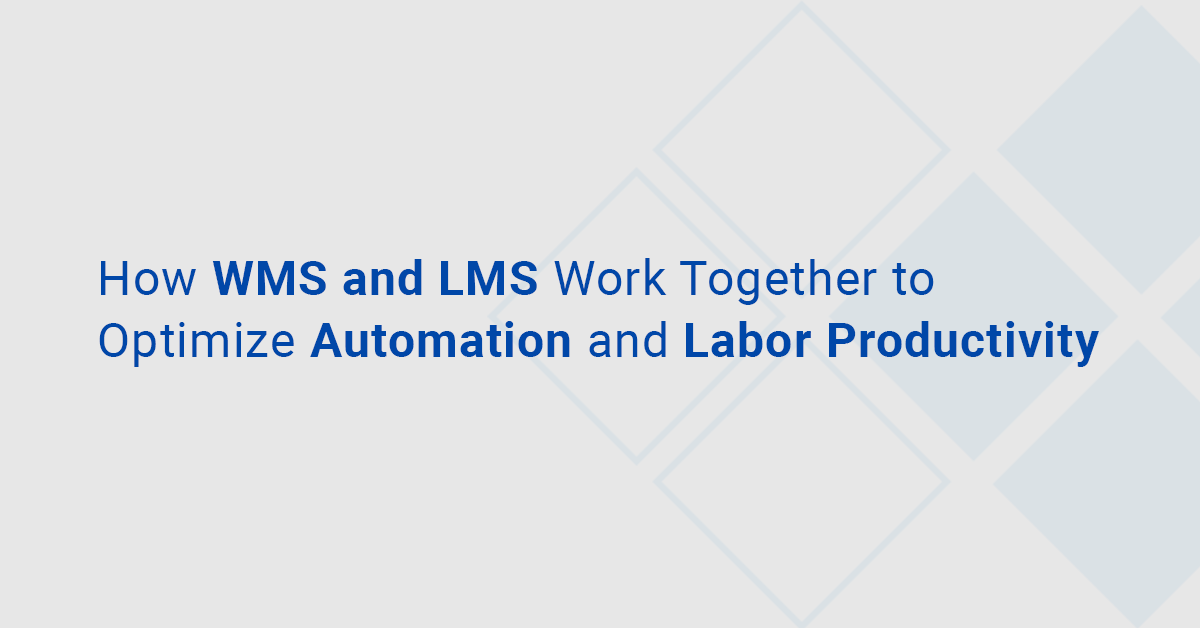Executive Summary:
- Leverage WMS for automation and LMS for labor optimization
- Continuous learning and adaptation are essential to successful labor and automation management
- Cultivating a performance-based culture is crucial for labor optimization
In today’s rapidly evolving supply chain landscape, where technology and automation continue to shape the way we operate, it’s essential for facilities to get the most out of both their automation processes and human labor. The best way to maximize overall productivity and optimize facility operations is to leverage the warehouse management system (WMS) and labor management system (LMS) in a seamless integration that improves the output of automation technology and people in tandem.
WMS: The Foundation for Automation
To understand the ideal synergy between WMS and LMS, it’s crucial to recognize that the WMS is the linchpin of warehouse operations. It serves as the master system responsible for orchestrating and managing various tasks within a facility, from inventory management to order fulfillment. The WMS acts as the system of record, ensuring inventory accuracy and efficient transactional processes.
In terms of automation, the WMS plays a vital role in managing and coordinating automated systems such as robotics, conveyor belts and other machinery. It directs these systems to perform tasks according to demand, optimizing the flow of goods within the warehouse. Think of the WMS as the foundation upon which automation is built—a crucial component in ensuring the efficient operation of an automated facility.
LMS: Optimizing Human Resources
Conversely, the LMS focuses on optimizing the human element within warehouse operations. It’s responsible for labor planning, tracking and performance management. The LMS helps determine the labor requirements needed to meet demand and ensures that labor resources are effectively managed while fulfilling orders.
The LMS operates at three distinct levels:
- Level 1: Tracking and Data Collection: At this level, the system primarily focuses on collecting data related to labor activities, providing visibility into workforce performance.
- Level 2: Establishing Engineered Standards: Level 2 involves using historical data to establish engineered labor standards based on multiple determinant elements and XYZ travel for tasks. This helps organizations set performance benchmarks and determine optimal processes.
- Level 3: Resource Planning and Preparedness: The highest level involves proactive planning based on predictive analytics, enabling the LMS to help allocate labor resources ahead of time to meet demand efficiently.
The true power of the LMS lies in its ability to fine-tune labor performance by identifying which resources are exceeding or falling below established standards. It allows for targeted training and process improvements to enhance overall efficiency.
Integration at Level 2: The Sweet Spot
The seamless integration of WMS and LMS becomes particularly critical at Level 2 of labor management. At this stage, organizations can optimize their warehouse operations by leveraging both systems to identify the sweet spot for automation. Here, automation is viewed as just another resource alongside human labor.
By combining data and insights from the WMS and LMS, warehouse managers can make informed decisions about where automation makes the most economic sense. This level of integration enables warehouse operations to benefit from the strengths of both automation and human labor.
The Role of a Performance-Based Culture
One of the keys to success in optimizing supply chain operations through the WMS and LMS is the cultivation of a performance-based culture. When employees are motivated to perform at their best, the entire operation benefits. This culture shift involves recognizing and rewarding top performers, offering performance coaching and support to those who may need improvement, and fostering a sense of friendly competition.
Performance boards, recognition programs and tangible rewards are effective tools in engaging employees and encouraging them to strive for excellence. A performance-based culture aligns with the objectives of both the WMS and LMS, which aim to maximize efficiency and productivity.
Examples of Integration Success
Successful integration of WMS and LMS systems can increase efficiency in several operational areas, including:
- Inventory Optimization: By using both systems collaboratively, organizations have reduced unnecessary walking and improved inventory accuracy by optimizing inventory slotting strategies.
- Labor Allocation: The integration can help allocate human and automation resources more effectively, leading to specialized workers being assigned to specific areas, for instance.
- Continuous Process Improvement: Through ongoing feedback and analysis of WMS and LMS data, companies can identify areas for process improvement and fine-tuning.
The Evolving Landscape of WES/WCS
In addition to WMS and LMS, Warehouse Execution Systems (WES) and Warehouse Control Systems (WCS) can play pivotal roles in managing warehouse automation and integrating them with labor programs. While these systems are often separate entities today, they may increasingly become integrated components of the WMS. The trend is moving toward a unified platform where the WMS orchestrates not only inventory and tasks but also automation at a more granular level with the LMS handling the critical labor-management aspects of the operation.
Ultimately, the key to success lies in cultivating a performance-based culture and remaining agile in an environment of constant change. Organizations with those assets in place will be best positioned to leverage their WMS and LMS to optimize automation and human labor and create more efficient and productive warehouse operations.
For more insights into how you can get the most out of your LMS and WMS, contact TZA to set up an introductory call.
Authors: John Seidl, Director, Partner Programs, TZA and Patrick Prasinos, Vice President, Business Development, Made4Net
Related TZA Resources:


